Ad
13-IntroJavascript.pptxIntroduction to java script
- 3. Why use client-side programming? PHP already allows us to create dynamic web pages. Why also use client-side scripting? client-side scripting (JavaScript) benefits: usability: can modify a page without having to post back to the server (faster UI) efficiency: can make small, quick changes to page without waiting for server event-driven: can respond to user actions like clicks and key presses CS380 3
- 4. Why use client-side programming? server-side programming (PHP) benefits: security: has access to server's private data; client can't see source code compatibility: not subject to browser compatibility issues power: can write files, open connections to servers, connect to databases, ... CS380 4
- 5. What is Javascript? a lightweight programming language ("scripting language") used to make web pages interactive insert dynamic text into HTML (ex: user name) react to events (ex: page load user click) get information about a user's computer (ex: browser type) perform calculations on user's computer (ex: form validation) CS380 5
- 6. What is Javascript? a web standard (but not supported identically by all browsers) NOT related to Java other than by name and some syntactic similarities CS380 6
- 7. Javascript vs Java interpreted, not compiled more relaxed syntax and rules fewer and "looser" data types variables don't need to be declared errors often silent (few exceptions) key construct is the function rather than the class "first-class" functions are used in many situations contained within a web page and integrates with its HTML/CSS content CS380 7
- 9. JavaScript vs. PHP similarities: both are interpreted, not compiled both are relaxed about syntax, rules, and types both are case-sensitive both have built-in regular expressions for powerful text processing CS380 9
- 10. JavaScript vs. PHP differences: JS is more object-oriented: noun.verb(), less procedural: verb(noun) JS focuses on user interfaces and interacting with a document; PHP is geared toward HTML output and file/form processing JS code runs on the client's browser; PHP code runs on the web server CS380 10 JS <3
- 11. Linking to a JavaScript file: script script tag should be placed in HTML page's head script code is stored in a separate .js file JS code can be placed directly in the HTML file's body or head (like CSS) but this is bad style (should separate content, presentation, and behavior CS380 11 <script src="filename" type="text/javascript"></script> HTML
- 12. Event-driven programming 12 split breaks apart a string into an array using a delimiter can also be used with regular expressions (seen later) join merges an array into a single string, placing a delimiter between them CS380
- 13. A JavaScript statement: alert a JS command that pops up a dialog box with a message CS380 13 alert("IE6 detected. Suck-mode enabled."); JS
- 14. Event-driven programming 14 you are used to programs start with a main method (or implicit main like in PHP) JavaScript programs instead wait for user actions called events and respond to them event-driven programming: writing programs driven by user events Let's write a page with a clickable button that pops up a "Hello, World" window... CS380
- 15. Buttons button's text appears inside tag; can also contain images To make a responsive button or other UI control: 1. choose the control (e.g. button) and event (e.g. mouse 1. click) of interest 2. write a JavaScript function to run when the event occurs 3. attach the function to the event on the control CS380 15 <button>Click me!</button> HTML
- 16. JavaScript functions 16 function name() { statement ; statement ; ... statement ; } JS the above could be the contents of example.js linked to our HTML page statements placed into functions can be evaluated in response to user events function myFunction() { alert("Hello!"); alert("How are you?"); } JS CS380
- 17. Event handlers JavaScript functions can be set as event handlers when you interact with the element, the function will execute onclick is just one of many event HTML attributes we'll use but popping up an alert window is disruptive and annoying CS380 17 <element attributes onclick="function();">... HTML <button onclick="myFunction();">Click me!</button> HTML
- 18. Document Object Model (DOM) most JS code manipulates elements on an HTML page we can examine elements' state e.g. see whether a box is checked we can change state e.g. insert some new text into a div we can change styles 18
- 20. Accessing elements: document.getElementById 20 var name = document.getElementById("id"); JS CS380 <button onclick="changeText();">Click me!</button> <span id="output">replace me</span> <input id="textbox" type="text" /> HTML function changeText() { var span = document.getElementById("output"); var textBox = document.getElementById("textbox"); textbox.style.color = "red"; } JS
- 21. Accessing elements: document.getElementById 21 document.getElementById returns the DOM object for an element with a given id can change the text inside most elements by setting the innerHTML property can change the text in form controls by setting the value property CS380
- 22. Changing element style: element.style 22 CS380 Attribute Property or style object color color padding padding background-color backgroundColor border-top-width borderTopWidth Font size fontSize Font famiy fontFamily
- 23. Preetify 23 CS380 function changeText() { //grab or initialize text here // font styles added by JS: text.style.fontSize = "13pt"; text.style.fontFamily = "Comic Sans MS"; text.style.color = "red"; // or pink? } JS
- 25. Variables variables are declared with the var keyword (case sensitive) types are not specified, but JS does have types ("loosely typed") Number, Boolean, String, Array, Object, Function, Null, Undefined can find out a variable's type by calling typeof CS380 25 var name = expression; JS var clientName = "Connie Client"; var age = 32; var weight = 127.4; JS
- 26. Number type integers and real numbers are the same type (no int vs. double) same operators: + - * / % ++ -- = += -= *= /= %= similar precedence to Java many operators auto-convert types: "2" * 3 is 6 CS380 26 var enrollment = 99; var medianGrade = 2.8; var credits = 5 + 4 + (2 * 3); JS
- 27. Comments (same as Java) identical to Java's comment syntax recall: 4 comment syntaxes HTML: <!-- comment --> CSS/JS/PHP: /* comment */ Java/JS/PHP: // comment PHP: # comment CS380 27 // single-line comment /* multi-line comment */ JS
- 28. Math object 28 var rand1to10 = Math.floor(Math.random() * 10 + 1); var three = Math.floor(Math.PI); JS CS380 methods: abs, ceil, cos, floor, log, max, min, pow, random, round, sin, sqrt, tan properties: E, PI
- 29. Special values: null and undefined 29 var ned = null; var benson = 9; // at this point in the code, // ned is null // benson's 9 // caroline is undefined JS CS380 undefined : has not been declared, does not exist null : exists, but was specifically assigned an empty or null value Why does JavaScript have both of these?
- 30. Logical operators 30 CS380 > < >= <= && || ! == != === !== most logical operators automatically convert types: 5 < "7" is true 42 == 42.0 is true "5.0" == 5 is true === and !== are strict equality tests; checks both type and value "5.0" === 5 is false
- 31. if/else statement (same as Java) 31 if (condition) { statements; } else if (condition) { statements; } else { statements; } JS CS380 identical structure to Java's if/else statement JavaScript allows almost anything as a condition
- 32. Boolean type 32 var iLike190M = true; var ieIsGood = "IE6" > 0; // false if ("web devevelopment is great") { /* true */ } if (0) { /* false */ } JS CS380 any value can be used as a Boolean "falsey" values: 0, 0.0, NaN, "", null, and undefined "truthy" values: anything else converting a value into a Boolean explicitly: var boolValue = Boolean(otherValue); var boolValue = !!(otherValue);
- 33. for loop (same as Java) 33 var sum = 0; for (var i = 0; i < 100; i++) { sum = sum + i; } JS var s1 = "hello"; var s2 = ""; for (var i = 0; i < s.length; i++) { s2 += s1.charAt(i) + s1.charAt(i); } // s2 stores "hheelllloo" JS CS380
- 34. while loops (same as Java) 34 while (condition) { statements; } JS CS380 break and continue keywords also behave as in Java do { statements; } while (condition); JS
- 35. Popup boxes 35 alert("message"); // message confirm("message"); // returns true or false prompt("message"); // returns user input string JS CS380
- 36. Arrays 36 var name = []; // empty array var name = [value, value, ..., value]; // pre-filled name[index] = value; // store element JS CS380 var ducks = ["Huey", "Dewey", "Louie"]; var stooges = []; // stooges.length is 0 stooges[0] = "Larry"; // stooges.length is 1 stooges[1] = "Moe"; // stooges.length is 2 stooges[4] = "Curly"; // stooges.length is 5 stooges[4] = "Shemp"; // stooges.length is 5 JS
- 37. Array methods 37 var a = ["Stef", "Jason"]; // Stef, Jason a.push("Brian"); // Stef, Jason, Brian a.unshift("Kelly"); // Kelly, Stef, Jason, Brian a.pop(); // Kelly, Stef, Jason a.shift(); // Stef, Jason a.sort(); // Jason, Stef JS array serves as many data structures: list, queue, stack, ... methods: concat, join, pop, push, reverse, shift, slice, sort, splice, toString, unshift push and pop add / remove from back unshift and shift add / remove from front shift and pop return the element that is removed
- 38. String type methods: charAt, charCodeAt, fromCharCode, indexOf, lastIndexOf, replace, split, substring, toLowerCase, toUpperCase charAt returns a one-letter String (there is no char type) length property (not a method as in Java) Strings can be specified with "" or '' concatenation with + : 38 var s = "Connie Client"; var fName = s.substring(0, s.indexOf(" ")); // "Connie" var len = s.length; // 13 var s2 = 'Melvin Merchant'; JS
- 39. More about String accessing the letters of a String: 39 var count = 10; var s1 = "" + count; // "10" var s2 = count + " bananas, ah ah ah!"; // "10 bananas, ah ah ah!" var n1 = parseInt("42 is the answer"); // 42 var n2 = parseFloat("booyah"); // NaN JS escape sequences behave as in Java: ' " & n t converting between numbers and Strings: var firstLetter = s[0]; // fails in IE var firstLetter = s.charAt(0); // does work in IE var lastLetter = s.charAt(s.length - 1); JS CS380
- 40. Splitting strings: split and join 40 var s = "the quick brown fox"; var a = s.split(" "); // ["the", "quick", "brown", "fox"] a.reverse(); // ["fox", "brown", "quick", "the"] s = a.join("!"); // "fox!brown!quick!the" JS split breaks apart a string into an array using a delimiter can also be used with regular expressions (seen later) join merges an array into a single string, placing a delimiter between them
Editor's Notes
- #3: client-side script: code runs in browser after page is sent back from server often this code manipulates the page or responds to user actions
- #16: Reset is not working here! Debug! test1.html
- #20: every element on the page has a corresponding DOM object access/modify the attributes of the DOM object with objectName.attributeName
- #21: span.innerHTML = textBox.value;
- #37: two ways to initialize an array length property (grows as needed when elements are added)

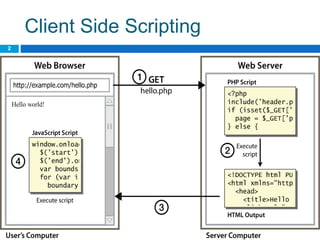
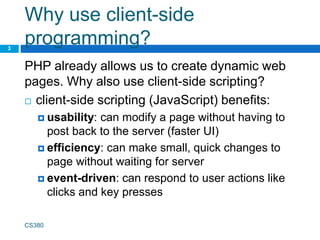
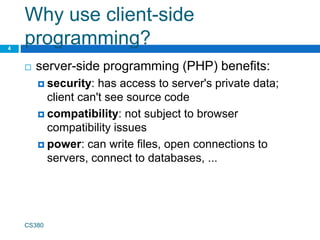




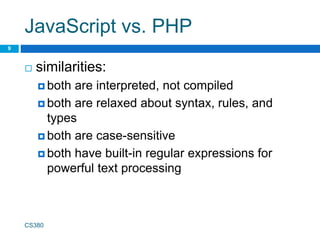













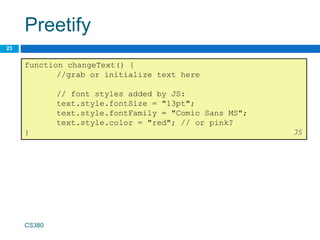



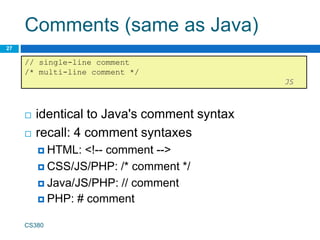

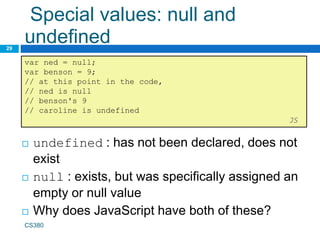

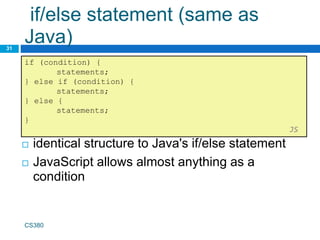

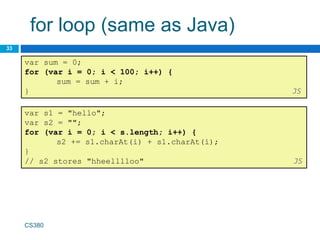


![Arrays
36
var name = []; // empty array
var name = [value, value, ..., value]; // pre-filled
name[index] = value; // store element
JS
CS380
var ducks = ["Huey", "Dewey", "Louie"];
var stooges = []; // stooges.length is 0
stooges[0] = "Larry"; // stooges.length is 1
stooges[1] = "Moe"; // stooges.length is 2
stooges[4] = "Curly"; // stooges.length is 5
stooges[4] = "Shemp"; // stooges.length is 5
JS](https://image.slidesharecdn.com/13-introjavascript-240601094131-88dd855e/85/13-IntroJavascript-pptxIntroduction-to-java-script-36-320.jpg)
![Array methods
37
var a = ["Stef", "Jason"]; // Stef, Jason
a.push("Brian"); // Stef, Jason, Brian
a.unshift("Kelly"); // Kelly, Stef, Jason, Brian
a.pop(); // Kelly, Stef, Jason
a.shift(); // Stef, Jason
a.sort(); // Jason, Stef
JS
array serves as many data structures: list,
queue, stack, ...
methods: concat, join, pop, push, reverse,
shift, slice, sort, splice, toString, unshift
push and pop add / remove from back
unshift and shift add / remove from front
shift and pop return the element that is removed](https://image.slidesharecdn.com/13-introjavascript-240601094131-88dd855e/85/13-IntroJavascript-pptxIntroduction-to-java-script-37-320.jpg)

![More about String
accessing the letters of a String:
39
var count = 10;
var s1 = "" + count; // "10"
var s2 = count + " bananas, ah ah ah!"; // "10 bananas, ah
ah ah!"
var n1 = parseInt("42 is the answer"); // 42
var n2 = parseFloat("booyah"); // NaN JS
escape sequences behave as in Java: ' " &
n t
converting between numbers and Strings:
var firstLetter = s[0]; // fails in IE
var firstLetter = s.charAt(0); // does work in IE
var lastLetter = s.charAt(s.length - 1); JS
CS380](https://image.slidesharecdn.com/13-introjavascript-240601094131-88dd855e/85/13-IntroJavascript-pptxIntroduction-to-java-script-39-320.jpg)
![Splitting strings: split and join
40
var s = "the quick brown fox";
var a = s.split(" "); // ["the", "quick", "brown", "fox"]
a.reverse(); // ["fox", "brown", "quick", "the"]
s = a.join("!"); // "fox!brown!quick!the"
JS
split breaks apart a string into an array using a
delimiter
can also be used with regular expressions (seen
later)
join merges an array into a single string,
placing a delimiter between them](https://image.slidesharecdn.com/13-introjavascript-240601094131-88dd855e/85/13-IntroJavascript-pptxIntroduction-to-java-script-40-320.jpg)















































